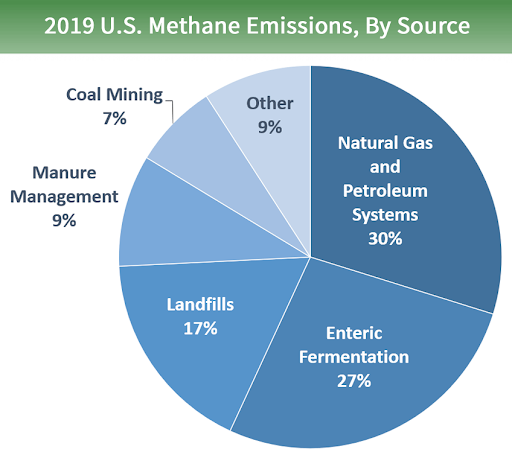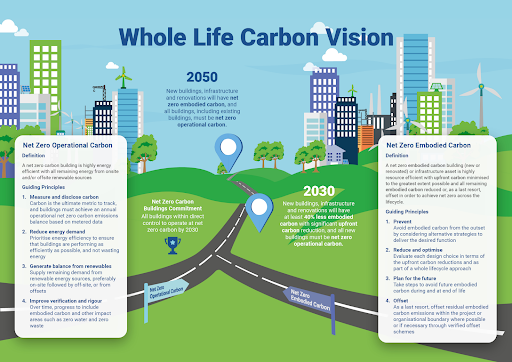Commercial Roofing as a Sustainability Benefit Multiplier
Embodied, Operational and Total Carbon
A holistic “total carbon” understanding and analysis is essential to decarbonizing the built environment. A paradigm shift away from the traditional segmented, compartmentalized, or—to use corporate speak—“siloed” way of designing, building, and doing business is essential to minimizing the effects of climate change. Using collaborative design from the start and encouraging scope creep is essential to understanding the interrelatedness and interconnections of the decisions we make. A holistic design approach viewed through the lens of “whole life carbon” is necessary to future-proof the built environment. “Business as usual” will only continue to provide the usual outcomes.
Operational Carbon
According to the World Green Building Council, net zero operational carbon building is a “highly energy efficient building with all remaining energy from onsite and/or offsite renewable sources.”19 From an operational point of view, this means the building has reduced energy demand and consumption to a low enough point that all of its energy needs can be provided by renewable energy.
Factors that influence the operational efficiency of a building from a building enclosure standpoint include continuity of insulation, airtightness, thermal bridges, fenestrations and—the opposite side of the same coin—air handling unit size and efficiency. Careful detailing and integration of the roof membrane (or vapor retarder) into the vertical wall air control layer and continuous thermal envelope with climate specific effective R-values should be evaluated as part of the complete building enclosure. Effective R-values, not nominal R-values, that include heat losses (or gains) from thermal bridges, should all be included and analyzed with holistic building energy models. Code minimum values may or may not be sufficient to meet the energy efficiency needs of the building and require a deep understanding of the interrelationships of building systems to find the most optimal energy balance between heat losses and heat gains. The Solar Reflectance Index (SRI) and not only its contribution to the energy efficiency of the building, but also how it relates to the urban heat island effect and the community at large should also be considered.
While lighting, plug loads and domestic hot water are also important to consider, they are variables mostly controlled by occupant behavior and have been left out of the discussion for the building enclosure focus of this article.
Passive design strategies, or the performance-driven Passive House Standard, are highly effective and have been well documented globally over the past 30 years. As Michael Tobias, the Founding Principal of NY Engineers recently noted, “A key benefit of passive house design is being able to heat and cool buildings at a very low cost, without affecting comfort. When a building is designed with these principles, it consumes 75-95 percent less energy than a traditional building.”20 However, one should be careful to not confuse “Passive House” with the “Passive Solar” movement of the 1970’s and 80’s. Modern passive houses, derived from the German “passivhaus,” are neither fully passive nor only for single family houses. The Passive House Standard applies to every building typology in every climate globally, including but not limited to schools, hospitals, prisons, offices, multi-unit residential, manufacturing, and single family homes. The key difference between passive solar and passive house is the addition of balanced heat recovery ventilation (HRV) or energy recovery ventilation (ERV). By reducing the energy demand for heating and cooling by 75-95 percent (as Tobias suggests) and transitioning to all electric mechanicals, the remaining energy consumption can easily and cost effectively be met by onsite renewables or community solar.
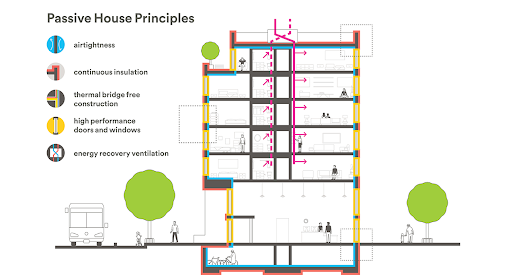
Image courtesy of the Building Energy Exchange
Thermal Bridging
“Thermal bridges are localized areas of high heat flow through walls, roofs, and other insulated building envelope components. Thermal bridging is caused by conductive elements that penetrate and/or bypass thermal insulation, and/or misaligned planes of thermal insulation. These paths allow heat flow to bypass the insulating layer, and reduce the effectiveness of the insulation.”21 As building enclosures become more insulated and more air tight, the effects of thermal bridging have a bigger impact on heat energy loss. In addition, thermal bridges can become locations of condensation which cause other moisture related issues such as conditions for mold growth and corrosion of building components.
Thermal bridges in roofing include, but are not limited to: parapets, mechanical fasteners, pipe penetrations, curbs, railings and structural components. Mechanical fasteners alone can contribute up to a 35 percent reduction or higher in effective R-values of roof assemblies.22 Strategies to reduce or eliminate thermal bridges include adhered roof assemblies, structural thermal breaks, and encapsulation of thermal bridges in insulation.
Photo courtesy of GAF
Thermal bridging from fasteners melting the snow.
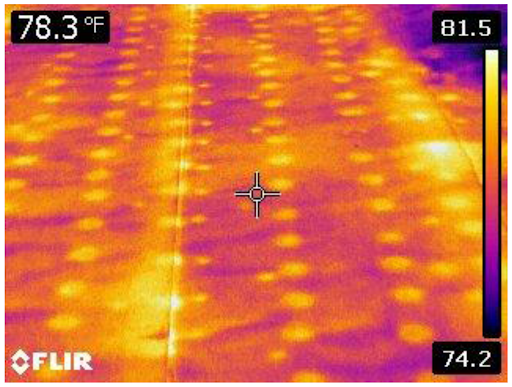
Image courtesy of GAF
Infrared photo of heat loss through mechanical fastener thermal bridging.
Image courtesy of Insulation Value Optimization for Low-Slope Roofs (Thomas Taylor et al, GAF)
Thermal bridging of roof fasteners.
Image courtesy of Insulation Value Optimization for Low-Slope Roofs (Thomas Taylor et al, GAF)
Isotherm model of thermal bridging from roof fasteners.
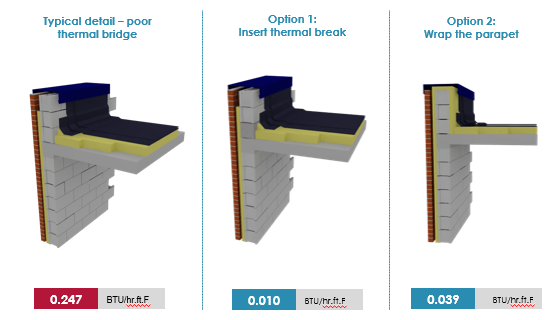
Image courtesy of the Passive House Network
Thermal bridging at parapets.
Embodied Carbon
Net zero embodied carbon, also called embodied energy, is a “building (new or renovated) or infrastructure asset [that] is highly resource efficient with upfront carbon minimized to the greatest extent possible and all remaining embodied carbon [is] reduced or, as a last resort, offset in order to achieve net zero [carbon] across its lifecycle.”23 In other words, the building materials and construction methods have utilized little or no fossil fuel energy sources during extraction, manufacturing processes, transportation, installation, maintenance, and disposal of building materials. In addition, aligned with the IPCC recommendations and as a co-benefit to reducing carbon, methane emissions from natural gas, coal and landfills are eliminated and/or minimized, with those primary energy sources being replaced by renewable energy.
Image courtesy of the World Green Building Council
Total carbon, also known as whole life or whole building carbon, is the sum of operational carbon and embodied carbon.
How Do We Measure Embodied Carbon?
Environmental Product Declarations (EPDs) are the best way to evaluate and compare embodied carbon of materials. EPD’s act like the MPG sticker on a new car. However, it's not always easy to compare EPD’s as they are not usually an “apples to apples” comparison, which can lead to inaccurate selection bias. In addition, EPD’s do not include operational carbon and only apply to the manufacturing and disposal phases of a product; nor do they include the replacement costs of carbon at the end of a product's useful life. For example, one type of roof may need to be replaced every 20-30 years while others can last significantly longer. Similarly, mechanicals may need to be replaced every 17-20 years. EPDs only account for the first carbon cost of a material or product. While huge improvements are being made to building material product transparency thanks to organizations like the International Living Future Institute (ILFI) and their Declare Label program to document manufacturing locations and end of life options, it doesn’t tell the full whole life carbon footprint story. See examples of an EPD and a Declare Label below.
Image courtesy of the U.S. Department of Energy
Environmental Product Declarations are similar to a nutrition label or a MPG sticker on a new car, except for a building material’s embodied carbon emissions.
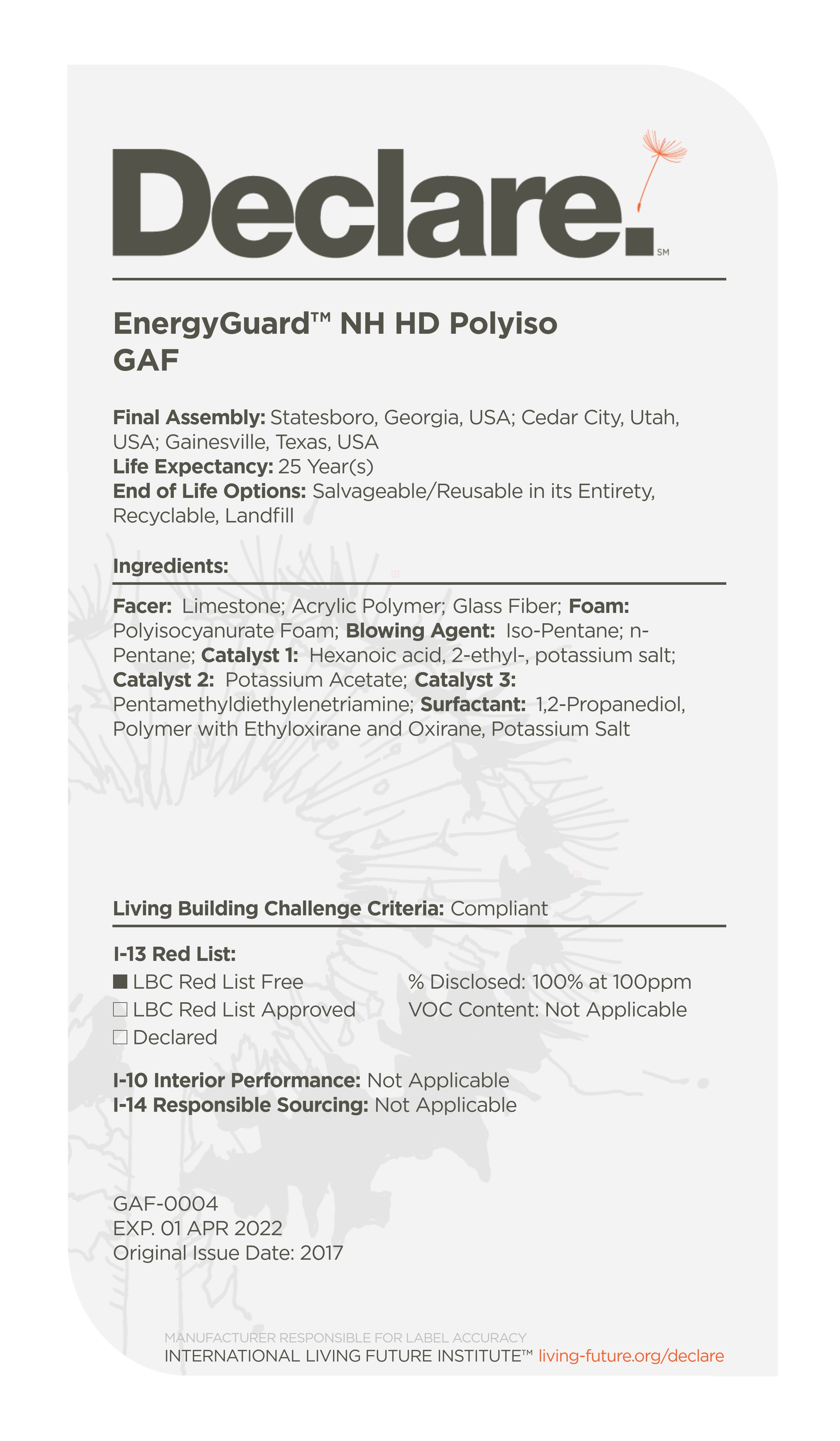
Image courtesy of ILFI and GAF
An example of a Declare Label for insulation.
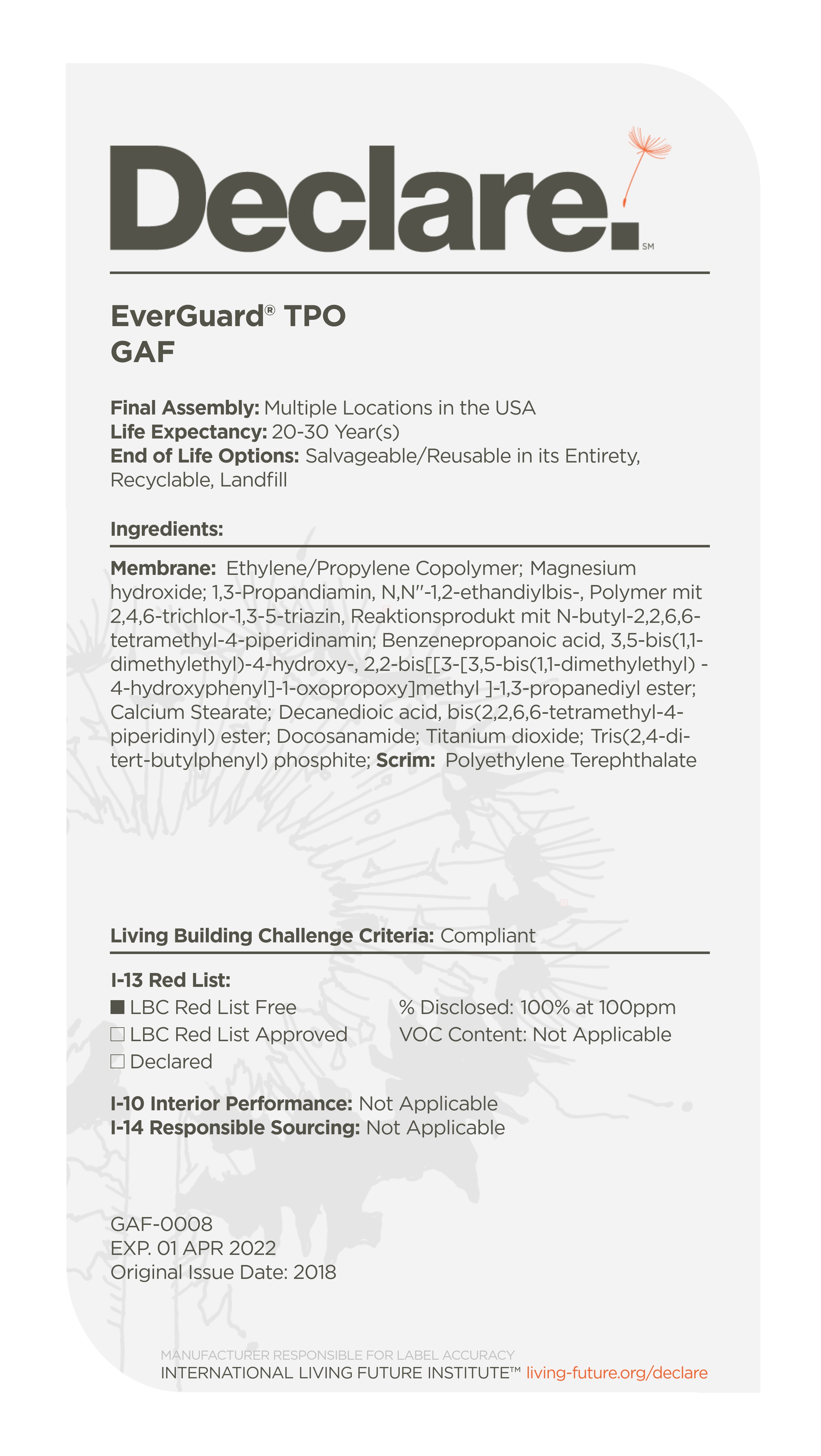
Image courtesy of ILFI and GAF
An example of a Declare Label for a roof membrane.
End of Life Options
According to the Ellen MacArthur Foundation,
“The circular economy is a systems solution framework that tackles global challenges like climate change, biodiversity loss, waste, and pollution. Furthermore, the circular economy is based on three principles, driven by design:
It is underpinned by a transition to renewable energy and materials. A circular economy decouples economic activity from the consumption of finite resources. It is a resilient system that is good for business, people and the environment.”24





